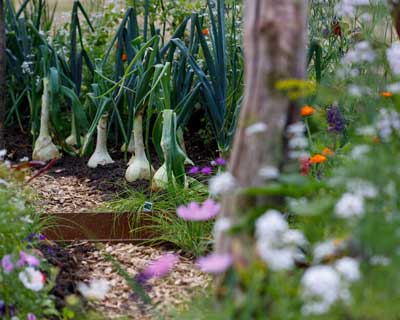Gardening the River Cottage way
Adam Crofts, Head Gardener at River Cottage HQ, reveals his tips for a productive veg garden, picks his top crops to grow at home and inspires with creative plant combinations
Owner Hugh Fearnley-Whittingstall’s food philosophy has an enduring appeal that seemingly winds the clock back to simpler times when food was grown and sourced close to home, its growth organic, sustainable and seasonal. At RHS Hampton Court 2022, the River Cottage Market Garden illustrated these values and showed how we can cultivate a small patch of land to grow the food we love to eat.
How do you start off a no-dig site?
Adam: On a new site we put clean cardboard down to kill off
What methods do you use to care for the soil?
Adam: Keeping the soil nutrient-rich and healthy is key. The main ways in which we help improve our soil are by:
-
Producing plenty of organic matter in the form of homemade compost. We use this to
mulch -
Feeding the soil with different organic crop-specific fertilisers that are made on site.
-
Growing green manures over winter, which help to smother weeds. Their roots prevent soil erosion and collect nitrogen.
-
Operating a no-dig organic practice, which means we don’t turn over the soil in the veg garden. When you turn the soil, you destroy micro-organisms that we ideally want to breed in the soil. Digging disturbs that habitat and it also brings weed seeds to the surface. Not digging also helps to store carbon in the soil.
Why is a compost heap so important?
Adam: Having a really good compost heap in your garden is absolutely key. Wormeries are great too – the resulting product is like supercharged compost. Many people give up if the compost heap becomes smelly or doesn’t rot down, but it’s all about getting the balance right:
-
Compost can potentially attract less-desirable wildlife so don’t have your heap too close to the house or your kitchen, but it needs to be practically sited so you don’t have a long way to walk with material to be composted. If you garden on a slope, put it at the top of the slope so you’re barrowing finished compost downhill to the beds.
-
Get a good mix of green and brown elements in the heap so nitrogen and carbon is balanced. As well as ‘green’ grass
cuttings
-
Make sure the heap has lots of air in it – turn the contents regularly with a garden fork to get the microbes working, which creates heat. Ideally the heap needs to get hot enough to kill weed seed – which is about 70 degrees. You can also push tubes into the heap so air travels in, then when you remove the tubes, the compost effectively has holes through it, which improves air flow. There are barrel-turning compost systems that let you turn and
aerate -
Cover the heap to stop it drying out in summer and keep an eye on it in case it needs watering. If you have a heap sitting too long and not rotting down, feed it with added manure, soil, chicken pellets or comfrey tea. You make this by steeping comfrey leaves in water in a lidded container. It does pong a bit!
-
Decent compost should have a nice earthy smell. We store ours in bins and let it settle.
Can you recommend any interesting plant combinations?
Adam: Fragrant flowers – We’ve started using more flowers in the veg garden over the past couple of years. Anything that is super-strong smelling deters pests from our veg crops, so we dot French marigolds around the garden, plant nasturtiums around the borders and grow fragrant thyme, rosemary and lavender.
Salsify and beans – Salsify is an old root crop that’s gone out of favour but it has a beautiful flower and makes a good companion plant for broad beans. Aphids head for the salsify plants, leaving alone the crop that we want to keep. This method is sometimes called sacrificial planting.
Three sisters – We grow sweetcorn, squash and beans together. Known as the Three Sisters, this combination works well because the sweetcorn supports the beans, the beans stabilise the corn and the shallow-rooted trailing squash plants smother weeds and reduce water evaporation.
Nectar-rich plants – We also grow plants that beneficial insects predate to encourage them into the garden.
Which plants would you recommend for a beginner veg gardener?
Adam: Salad crops are easy to grow and quick to mature yet relatively expensive to buy and often don’t store particularly well. Eaten fresh from the garden, crisp, tasty salad crops are one of the true delights of veg growing. Lettuce (such as ‘Maureen’, a ‘Little Gem’ type), beetroot, spring onions, radishes, peas and beans all give good results. Brassicas can be tricky because they attract pests, so I’d probably leave these alone.
My main tip for beginner gardeners is don’t over-complicate things and try too many different crops all at once – just grow a few plants of each type of veg and see what works for you.
Get a notebook and keep records of anything you’ve grown and liked so you can tailor what you grow in future years.


